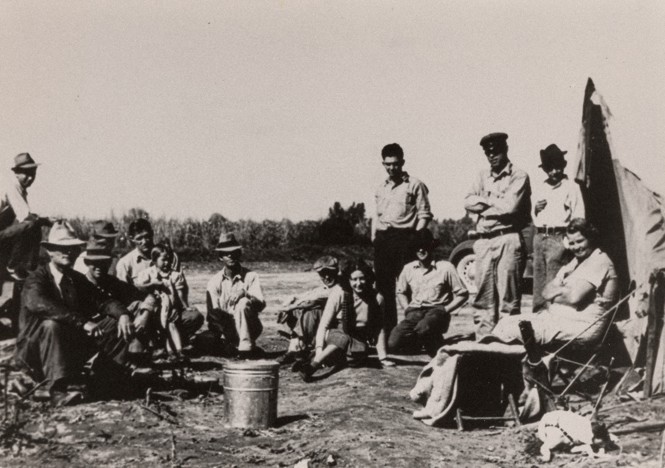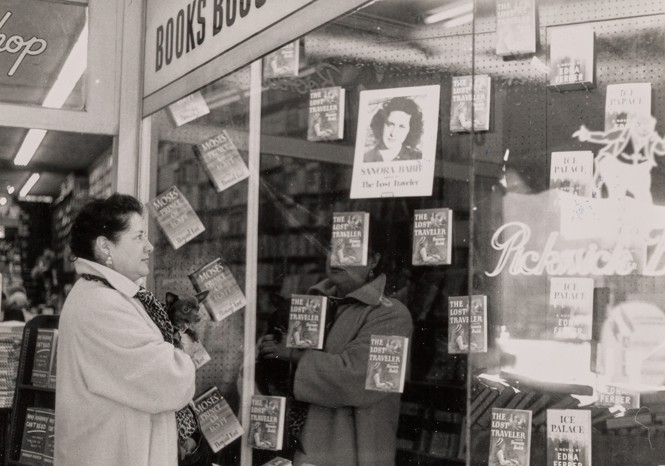The Woman Who Would Be Steinbeck
John Steinbeck beat Sanora Babb to the great American Dust Bowl novel—using her field notes. What do we owe her today?

It is likely, but by no means certain, that in May 1938, the writers John Steinbeck and Sanora Babb met in a café near Arvin, California. Both were in town to chronicle the plight of migrants who were flooding the state to escape the decimation of the Dust Bowl. Both were writing fiction about it—Steinbeck had abandoned two novels on the subject earlier that year, while Babb had received an enthusiastic response from Random House for the opening chapters of her novel in progress, Whose Names Are Unknown. And both were connected to Tom Collins, a staffer at the Farm Security Administration (FSA), a federal agency providing aid to the migrants. To Steinbeck, Collins was a friend and a passkey to the migrant experience. To Babb, he was a mentor and supervisor; she had volunteered to document living conditions in the camps.
What happened next is in some ways clear as day, in others frustratingly fuzzy. The clear part is a tale of profound literary unfairness: Steinbeck received FSA field notes, compiled largely (but not entirely) from Babb’s observations and interviews, after which he began a punishing 100-day writing sprint to produce The Grapes of Wrath, the foundational American novel about the Great Depression. Babb’s book, delivered later, would be scotched. The Random House co-founder Bennett Cerf alerted Babb that she was late to the finish line in August 1939. “What rotten luck for you that ‘The Grapes of Wrath’ should not only have come out before your book was submitted but should have so swept the country!” Cerf wrote. “Obviously, another book at this time about exactly the same subject would be a sad anticlimax!”
Here’s the fuzzy part: Over time, an understandably frustrated Babb would insist that she, not Collins, had personally handed over the reports to Steinbeck—an act that would make his appropriation look more brazen and personal. “Tom asked me to give him my notes,” Babb would write 40 years after that alleged café meeting. “I did. Naïve me.” It doesn’t appear that Steinbeck ever wrote about meeting Babb, or even mentioned her by name, though it’s plausible that two diligent reporters on the same beat would want to compare notes.
Fuzzier still is the question of how much of Grapes was written on the back of the FSA notes, how much of that research was Babb’s—and how much it matters. Her observations almost certainly helped Steinbeck shape his rendering of the migrants. Babb’s entries were rich and thorough—having grown up on a failing farm in the Oklahoma panhandle, she was particularly trusted by Collins to connect with the migrants. When Babb shared her jottings, directly or indirectly, she was likely motivated by the urge to get their experience across through whatever medium might help them.
So what would you call the ensuing fame of one novel and the preemptive burial of another? Appropriation? Theft? Bad timing? Sexism? Perhaps, in the end, it was simply evidence of a cruel flaw of publishing: Sometimes its decision makers conclude—not always for good reasons—that there isn’t room for many stories about one major event. That a short-term judgment about what the market will bear can choke off a literary legacy and, to some extent, impoverish a culture.
One virtue of Iris Jamahl Dunkle’s new biography, Riding Like the Wind: The Life of Sanora Babb, is that it keeps Steinbeck off the stage for as long as possible. Despite Babb’s rotten luck, as Cerf put it, the editor’s snub wasn’t the defining element of her life and career. A dedicated leftist, she’d published fiction and reportage in little magazines and journals such as New Masses, befriending working-class writers including William Saroyan and Nelson Algren. She had a long marriage to the Oscar-winning cinematographer James Wong Howe that sometimes bent but didn’t break under the pressure of his work. And though Grapes derailed her career, Babb never stopped mining her childhood for material. In Oklahoma, Colorado, and Kansas, she’d experienced poverty, crop failures, and an absent dad; her mother struggled to keep a bakery running while her father chased illusory dreams as a gambler and semipro baseball player. Wind highlights Babb’s determination to chronicle such deprivation while writing her way out of it.
This personal history, according to Dunkle, goes some way toward explaining why Babb might have made the career-crippling decision to open-source her notes. “You have to understand that Sanora Babb came from a communist, liberal background—she was a community-based writer,” Dunkle told me over Zoom from UC Davis, where she is a lecturer in the English department. “She was part of a writers’ group for 40 years with Ray Bradbury,” and professional collaboration was baked into her ethos. “I don’t think she thought that Steinbeck would appropriate things from her notes and that it would make it impossible for her to publish her book.”
[Read: Plagiarism is the next “fake news”]
Riding Like the Wind doesn’t argue that Steinbeck plagiarized Babb, but rather asserts that he appropriated her writing without credit; it also suggests that the scope and perspective of The Grapes of Wrath didn’t become clear to Steinbeck until he had those notes in hand. Dunkle quotes Steinbeck himself to show that the field reports commissioned by Collins (one of the people to whom Grapes was dedicated) were essential to an authentic portrayal of his milieu: “Letter from Tom with vital information to be used later. He is good,” the author wrote in his diary while toiling over his novel. “I need this stuff. It is exact and just the thing that will be used against me if I am wrong.”
Although Dunkle’s framing is backed by fresh evidence, some fuzziness persists. In his 2020 biography of Steinbeck, Mad at the World, William Souder expresses skepticism about whether Babb actually met Steinbeck—or would have willingly handed over notes she was using for her own novel. Speaking to me on the phone from his home in Minnesota, he deferred to Dunkle’s research (and Babb’s statements) on that point, but said it is difficult to discern what material of Babb’s was used, and how.
Souder and other scholars have detected echoes of Babb’s notes in Grapes. Her observations about the migrants’ “mortgage-lost farms, bank-claimed machinery and animals, dust-ruined acres” have the same biblical cadence that Steinbeck mastered in his novel. Their descriptions of stillborn babies are similar; both use creatures like insects and turtles as metaphors for the migrants’ plight.
Without direct evidence, however, a definitive link can’t be proved; both authors were, after all, in the same place at the same time. “It’s really hard to disentangle things and say, ‘Well, this idea comes from Steinbeck; this idea comes from Babb,’” Souder said. “I think that’s borderline impossible.”
And Steinbeck had at least as much right to the subject. He had been writing about Dust Bowl migrants well before meeting Babb; in 1936, he wrote dispatches on them for the San Francisco News; that same year, he published In Dubious Battle, about a California fruit-worker strike. “He’s a native of California,” Peter Van Coutren, an archivist at the Martha Heasley Cox Center for Steinbeck Studies at San Jose State University, told me. “He is a keen observer of what’s … happening here in California, and he’s looking for a way to promote his ideals of fairness, human rights, and human equality.”
For all the parallels, a reader would be unlikely to mistake one novel for the other. Their plots rhyme, especially in the latter chapters, which concern migrant families trapped and exploited by low-paying conglomerate farms. But where Grapes is relentlessly symphonic and often melodramatic, Unknown—which was finally edited and released 20 years ago—is intimate and restrained, focusing acutely on the slow-motion erosion of the agrarian American dream in a pattern of exploitation that the Dust Bowl only intensified. Its portrait of an Oklahoma-panhandle community undone by dust storms, depicting miscarriage and suicide along with economic devastation, is visceral and honed, more in line with Algren than Steinbeck.
Babb had a gift for weaving together individual desperation and systemic failure. In a fine section in the first half of Unknown, a family patriarch, Milt, contemplates the coming weather and practically wills it to save his family:
He looked at the edges of the sky, hoping for clouds or the steely haze that might mean early snow. Off to the northwest a bank of clouds lay just darker than the sky, still like a great animal waiting to spring, showing the sleepy fire of its eyes when the faint autumn lightning winked. It was far away and would spend its strength on other land. His wheat and that of every other prairie farm was waiting in the ground for rain.
In his “rotten luck” letter, Cerf wrote to Babb that “the last third of your book is so completely like ‘The Grapes of Wrath’ that the families and characters might basically be interchanged in the two.” This is exactly right but also completely misses the point: Collective experiences are, by their nature, shared, but Babb’s characterization of them was wholly her own. And while Grapes chronicles the injustices that migrants faced in California, Unknown shows how farmers struggled with them in Oklahoma, bringing their dread and suspicions of authority westward.
Two writers with divergent styles, both capturing a cataclysmic American event: It’s difficult to believe the marketplace didn’t have room for them both. “The excuse given by Cerf that the field was too crowded to hold another novel of the same seems flimsy at best,” Van Coutren, of the Steinbeck Center, told me. “So I imagine there was some other push for him to come up with a reason to dismiss her, and I see that dismissal … as, most likely, because she was a young woman writer who was just getting started.”
[Read: The hazards of writing while female]
This is Dunkle’s conclusion as well, and it’s a reasonable one. The publishing industry could accommodate contemporaneous World War II novels about the Pacific Theater, including From Here to Eternity and The Caine Mutiny; Henry Roth’s Call It Sleep opened the door for Jewish American immigrant literature, rather than slamming it shut.
The closest parallels to Babb’s predicament might be the fate of innovators such as Alfred Russel Wallace, who came up with the concept of natural selection around the same time as Charles Darwin, or Gottfried Liebniz, who developed a variant of calculus just as Isaac Newton did. But fiction isn’t science. It’s a study in emotion and perspective, and Grapes and Unknown are distinct books. Dunkle said that Grapes of Wrath makes her think of her grandmother, who grew up in Oklahoma. When Dunkle told her that she was reading Grapes in class, her grandmother snapped: Don’t ever talk to me about Steinbeck again. “She hated the book,” Dunkle recalled, “and I couldn’t understand why.” But the more closely she read the influential novel, the more she noticed Steinbeck’s tendency to depict his characters as victims with little agency of their own.
Dunkle’s book may help elevate Babb’s status, not simply because it so thoroughly explores the Steinbeck affair but because it succeeds at doing what all good literary biographies do: It makes a case for reading old writing in new ways. Steinbeck thrived in an era when sweep and melodrama and heft—not to mention manliness—signified quality literature. Babb, arguably, speaks more directly to this moment, which rewards clear portraits of marginalization and a grasp of how sociopolitical forces shape everyday relationships. Babb didn’t get the chance she deserved, but she knew as well as anyone how much the world was suffused with unfairness alongside hope and ambition. It’s right there in the final line of Unknown: “They would rise and fall and, in their falling, rise again.”
What's Your Reaction?




















